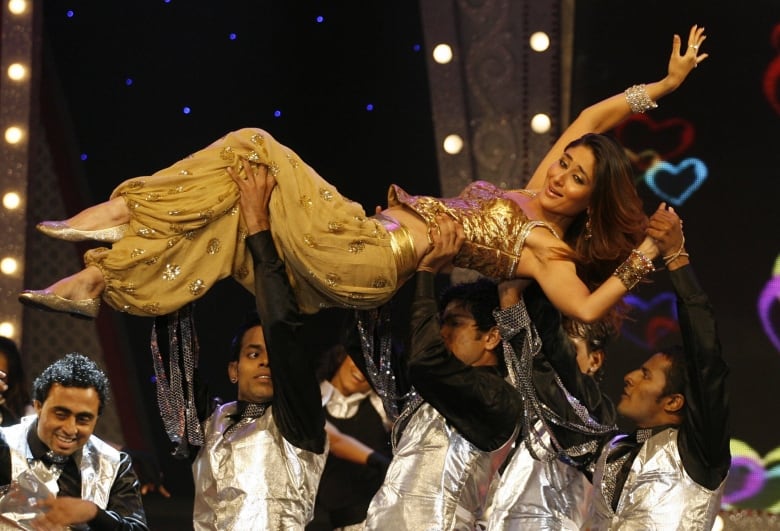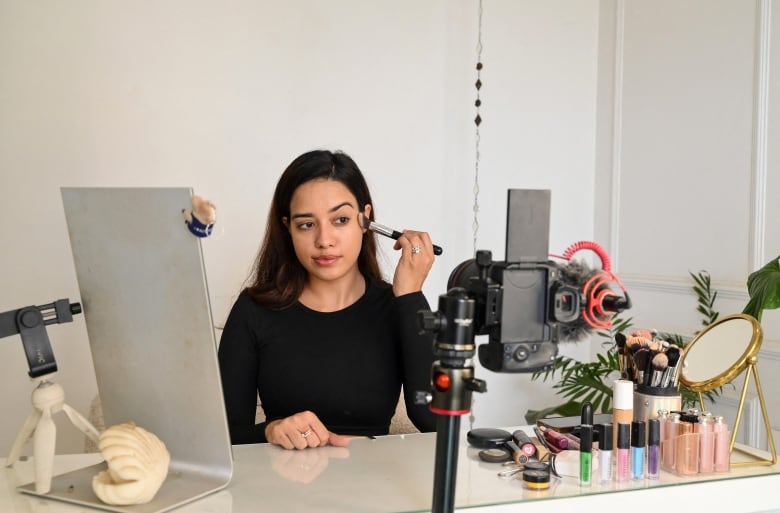There’s a new makeup trend taking social media by storm, with videos racking up tens of millions of views and influencers going viral just for trying it, and Canadians have some of the most popular versions.
The Asoka makeup trend has generated hundreds of thousands of posts on TikTok. In the videos, creators style themselves with Indian bridal hair, makeup and clothing to the music from a version of the song San Sanana from the 2001 Bollywood movie Asoka starring Kareena Kapoor Khan and Shah Rukh Khan.
“This viral trend pays homage to the film and also to the timeless beauty of Indian culture and its influence on make-up and fashion,” notes Times of India, an Indian news site.
The trend isn’t so much about the movie itself, a biopic with mixed reviews, receiving 6.4/10 on IMDB and average 69 per cent on Rotten Tomatoes. According to Times of India, it’s sort of an homage to Khan’s character, who “flaunts ancient Indian attire and bold kohl-rimmed eyeliner,” but with an Indian bridal twist (for this reason, it’s also called the Indian bridal makeup trend).
The videos are complex and highly stylized, involving quick cuts, synchronized hand gestures, facial expressions, lip syncing and head movements, plus bold colours and makeup similar to some of the styles featured in the film, including the bindi. Creators from around the world have posted that it’s sometimes taken them eight hours or more to film their clips.
Influencer Durka Murugananthan, 27, of Stouffville, Ont., posted a video last week that has nearly two million views, and a second Tamil version of the trend Monday morning that already had more than 112,400 views by Monday evening.
Asoka makeup trend or not, it’s been amazing just to see the rise of so many South Asian influencers and South Asian representation in the beauty space, Murugananthan told CBC News.
“We deserve that space as much as the next person, but I feel like we’re just starting to break down that barrier, and it’s really nice to see,” Murugananthan said.
The Bollywood esthetic
Indian cinema or Hindi-language cinema, also known as Bollywood, is the world’s biggest film industry and known for its song-and-dance sequences, romantic dramas and fantastical fashion. Kareena Kapoor Khan is an A-lister icon in this space, both for her roles — she’s starred in at least 70 films, according to Indian Express — and for her influence on fashion (HELLO! India calls her a “true-blue fashion icon on the silver screen.”)
The Asoka trend isn’t surprising given how important the esthetic element is to Bollywood, and TikTok’s preoccupation with beauty and makeup routines, said Faiza Hirji, an associate professor in the department of communication studies and media arts at McMaster University in Hamilton, Ont.

Think of all the trending “get ready with me” videos, where influencers just show their skin care and makeup routines, and the “Sephora Kids” trend of children obsessed with skin products. It’s little wonder, then, that a look that emphasizes heavy, stylized makeup, glamour and prioritizes beauty (many Bollywood stars were former beauty queens) would take off, Hirji told CBC News.
“As an overall trend, I sometimes do wonder a little bit about how much of a focus beauty has become on TikTok, but if it’s going to be a focus, I think it’s great to have a diverse aspect to it, as well,” said Hirji, who is also the author of Dreaming in Canadian: South Asian Youth, Bollywood and Belonging.
She noted there are also more South Asian influencers recently as more women feel empowered to pursue these channels to promote themselves. For instance, Indian makeup influencer Debasree Banerjee has fans around the world. Now, that influence is percolating, Hirji said.
“It naturally follows, I think … that they’re going to reflect the things that influence them, which I think is amazing.”

Murugananthan said a lot of girls look up to her and other South Asian beauty influencers. It’s important to her to be a role model in the beauty space because it’s not something she experienced growing up.
“We didn’t see that. We didn’t even see that in mainstream media, we didn’t see it on television — we didn’t see it anywhere,” she said.
“Now seeing us being able to do this as a career, and to see us even just being passionate about something other than, you know, becoming a doctor, I think that’s amazing.”
Drag queen Jolene Sloan is pushing for more representation of drag in the South Asian LGBTQ community, with Bollywood music, Indian glam and a message that promotes culture and self-acceptance.
The problem with ‘exotic’
While Hirji agrees the trend is positive, she does find it a little problematic when people who aren’t Indian reproduce a look that has cultural significance to many people simply because it’s exotic or trendy, or treated more like a costume.
That’s similar to some of the criticisms on social media, where people are suggesting some of the videos posted by people from other backgrounds are cultural appropriation.
“Where are all these non-Desis finding cultural clothing,” one person wrote on TikTok.
“Don’t even get me started on all the non-South Asian people low-key mocking this trend,” another person said in a video.
It’s complicated, Hirji said, because often Indian people who wear traditional clothing are singled out or criticized, and a lot of people of South Asian origin who grow up in the West learn to feel self-conscious. Then, when a non-Indian person wears Indian jewlery or clothing, it seems to become more culturally acceptable.
“To me there’s something problematic when some people who wear it are subject to a racist backlash and others are not,” Hirji said.
That said, some of the most popular videos of the Asoka trend have been created by South Asian influencers, such as Canadian Dhivya Sri, a beauty influencer based in Ottawa. Her video, posted three days ago, already had 33.4 million views Monday evening. A behind-the-scenes video of its making has 37.3 million views.
“You guys are blowing this video up,” Sri laughs in a video posted just after she published the original, in which she explains that it took eight hours from start to finish.
“For the past week, I have seen so many of these videos on my for you page, and I really, really wanted to do it because it looked so fun.”
.jpg)



